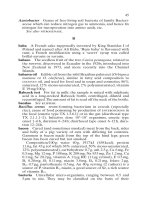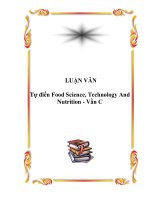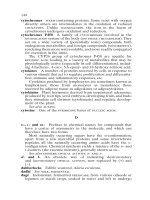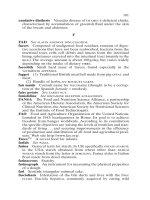Food starch technology docx
Bạn đang xem bản rút gọn của tài liệu. Xem và tải ngay bản đầy đủ của tài liệu tại đây (1.42 MB, 17 trang )
Food starch technology
[cover photo]
National researchers utilize advanced instrumentation, such as computerized image analyzers
and scanning electron microscopes, to determine starch granule size and distribution and to
analyze surface morphology.
Food starch technology
a global commitment
National Starch and Chemical Company is the worldwide leader in specialty starch technology
and production. With technical service facilities in over 20 countries on five continents, National
is constantly striving to develop new food starches with new characteristics for its customers
around the globe.
We back up our commitment by building state of the art starch production facilities, investing in
advanced analytical equipment, expanding our food pilot plants and maintaining an expert staff
of chemists and technologists. It is a fully integrated process that also encompasses the genetic
breeding of our own seed corn to develop starch characteristics the marketplace demands.
What follows is a brief introduction of the technical knowledge obtained in the development of
food starches and their applications. We have examined the sources and manufacturing
processes, the chemical and physical structure and the phenomenon of gelatinization. We have
also explained the reasons for modification, specifically crosslinking and stabilization. Finally,
we discuss application technology - interaction of ingredients, processing and equipment.
Introduction
In nature starch is available in an abundance surpassed only by cellulose as a naturally occurring
organic compound. It is found in all forms of green leafed plants, located in their roots, stems,
seeds or fruits. Starch serves the plant as food for energy during dormancy and germination. It
serves similar purposes for man and animal as well as lower forms of life. Man, however, has
found uses for starch that extend far beyond its original design as a source of biological energy.
Practically every industry in existence uses starch or its derivatives in one form or another. In
foods and pharmaceuticals starch is used to influence or control such characteristics as texture,
aesthetics, moisture, consistency and shelf stability. It can be used to bind or to disintegrate; to
expand or to densify; to clarify or to opacify; to attract moisture or to inhibit moisture; to
produce short texture or stringy texture, smooth texture or pulpy texture, soft coatings or crisp
coatings. It can be used to stabilize emulsions or to form oil resistant films. Starch can be used to
aid processing, packaging, lubrication or moisture equilibration.
Starch truly serves as a multifunctional ingredient in the food industry.
Sources of Starch
The most common sources of food starch are corn, potato, wheat, tapioca and rice. Corn is
cultivated in warmer climates, with half of the world’s production grown in the U.S.A., its
biggest crop. China, the second largest producer in the world, grows about 10%. Approximately
70% of the world’s potato supply is grown in the cool, moist climate of Europe and Russia.
Wheat, requiring a more temperate climate, is primarily grown in the former USSR, North
America and Europe. Approximately 90% of world rice production comes from South and
Southeast Asia, while tapioca is cultivated in the narrow tropical band about the equator.
Wet Milling of Corn
Corn starch is extracted from the kernel through a process of wet milling. The process employs
techniques of grinding, screening and centrifugation to separate purified starch from fiber, oil
and tightly bound protein. (Fig. 1).
The wet milling process begins with softening of the kernel by steeping it in a dilute acid
solution. Coarse grinding splits the kernel to remove the oil-containing germ. Finer milling
separates the fiber from the endosperm which is then centrifuged to separate the less dense
protein from the more dense starch. The starch is then washed and dried or left in a slurry for
further processing, such as cross-linking.
Structure
The building blocks of carbohydrates are α-D and β-D glucose which contain six (6) carbon
atoms and form pyranose rings. Through enzymatic condensation, one molecule of water is split
out between two molecules of glucose to form a bond. This condensation occurs predominantly
between carbons 1 and 4 (Fig. 2) but occasionally between 1 and 6.
Where only the α-1,4 linkage develops, a linear chained homopolymer results which we refer to
as amylose. (Fig.3). The length of this chain will vary with plant source but in general the
average length will run between 500 and 2,000 glucose units.*
(*Traditionally, amylose is considered as being only linear in configuration, but recent
investigations indicate the presence of limited branching in some amylose molecules. However,
for the sake of simplicity and better understanding of the properties of amylose, this presentation
will ignore those findings and consider amylose as linear only.)
It is interesting to note that amylose and cellulose are very similar in structure with the single
exception of the spatial arrangement of the bridging between the numbers 1 and 4 carbons. The
beta glucose form found in cellulose results in a rigid molecule with strong intermolecular
bonding which is not digestible by humans. The alpha linkage of amylose allows it to be flexible
and humanly digestible.
The second type of polymer in starch develops when the enzymatic condensation between
glucose units occurs at carbons 1 and 6. This occasional linkage, along with the predominant 1,4
bonding, results in a branching effect and the development of a molecule much more massive in
size than amylose but with linear chain lengths of only 25-30 glucose units. This molecule is
called amylopectin. (Fig. 4).
All starches are made up of one or both of these molecules, but the ratio of one to the other will
vary with the starch source. Corn has about 25-28% amylose with the remainder being
amylopectin. High amylose corn can run as high as 80%. Tapioca has about 17% amylose, and
waxy maize has virtually none.
As might be predicted from this data, the cooked characteristics of tapioca lie somewhere
between those of corn and waxy maize, and the characteristics of corn are greatly accentuated in
high amylose corn.
The Starch Granule
As the plant produces the starch molecules, it deposits them in successive layers around a central
hilum to form a tightly packed granule. Wherever possible, adjacent amylose molecules and
outer branches of amylopectin associate through hydrogen bonding in a parallel fashion to give
radially oriented, crystalline bundles known as “micelles.” These micelles hold the granule
together to permit swelling in heated water without the complete disruption and solubilization of
the individual starch molecules. (Fig.5).
These highly oriented and crystalline micellular areas explain the ability of ungelatinized starch
granules to rotate a plane of polarized light to produce characteristic interference crosses. This
bi-refringent cross is one of the features used in identifying starch source. When the radial
orientation of the crystalline micelle is disturbed, the bi-refringent cross disappears. (Fig. 6).
Gelatinization
Gelatinization temperatures are considered as ranges covering the temperatures at which loss of
bi-refringence is first noticed and less than 10% remains. This temperature range is greatly
influenced by the binding forces within the granule which vary with species. High amylose corn
has much greater bonding force than the other maize varieties due to the high degree of linearity
within the granule. On the other hand, orthophosphate ester groups within the potato granule tend
to weaken bonding and lower energy requirements to gelatinize.
When the starch granule is heated in water, the weaker hydrogen bonds in the amorphous areas
are ruptured and the granule swells with progressive hydration. The more tightly bound micelles
remain intact, holding the granule together. Birefringence is lost. As the granule continues to
expand, more water is imbibed, clarity is improved, more space is occupied, movement is
restricted and viscosity increased.
With the swelling of amylose-containing granules such as corn, the amylose molecules are
solubilized and leach out into solution. These molecules will then reassociate into aggregates and
precipitate at low concentrations or set to a gel at higher starch concentrations. This is referred to
as “set back” or retrogradation. The congealed paste will become cloudy and opaque with time
and will eventually release water to shrink into a rubbery consistency (Fig. 7).
Waxy maize has essentially no linear amylose molecules so its paste will remain flowable and
clear. It will not gel or weep.
Tapioca, having a small amount of amylose, gives a soft gel when pasted. Pastes from high
amylose starch set to a very stiff gel.
To summarize the physical changes during gelatinization: the granule swells and loses
birefringence; clarity and viscosity increase; and smaller linear molecules (if present) dissolve
and reassociate to form a gel.
Brabender Amylographs
To follow the viscosity behavior of starch while cooking, we use the Brabender
Viscoamylograph. The starch suspension is heated in a revolving cup to a designated temperature
and held there, as the viscosity is measured through resistance exerted on a stirrer suspended in
the pasted starch. A continuous recording of this resistance is marked on a moving chart. The
resulting graphical curve records the point of gelatinization, the rate of viscosity development,
the peak viscosity and the rate of viscosity breakdown. If desired, further viscosity information
can be recorded during the cooling cycle.
Corn starch heated in water to 95°C will show a rather rapid increase in viscosity after
gelatinization until it reaches a peak. The viscosity will gradually decrease during the holding
period, then dramatically increase again as the paste cools and retrogrades.
Waxy maize will increase in viscosity at a more rapid rate than regular corn. The peak viscosity
for waxy maize will be greater and will be attained sooner. However, it will also break down in
viscosity faster and to a greater extent. On cooling, waxy maize shows little increase in viscosity
because it does not gel. (Fig. 8).
Potato starch will absorb more water, showing a high initial peak viscosity, when compared to
other native starches. The gelatinization temperature is lower, causing the solution to thicken
quickly on heating. The high peak viscosity falls rapidly during this holding period. The solution
shows little tendency to retrograde on cooling.
Tapioca starch gelatinizes at a temperature between that of waxy maize and corn, and has a
slightly lower viscosity than waxy maize. The cooled solution retrogrades to produce a soft gel.
Solutions of cooked tapioca are characterized by a greater clarity when compared to other native
starches.
Why Modify Starch?
In the unmodified form, starches have limited use in the food industry. Waxy maize starch is a
good example. The unmodified granules hydrate with ease, swell rapidly, rupture, lose viscosity
and produce weak bodied, very stringy and very cohesive pastes. We modify starch to enhance
or repress its inherent properties as appropriate for a specific application: to provide thickening,
improve binding, increase stability, to improve mouthfeel and sheen, to gel, disperse or cloud.
Cross-linking
We cross-link to control texture and to provide heat, acid and shear tolerance. As a result, we
have better control and improved flexibility in dealing with formulation, processing and product
shelf-life. Cross-linking of starch can be thought of as a means to “spot weld” the granule at
random locations, reinforcing hydrogen bonding and inhibiting granule swell. (Fig. 9).
This cross-linking treatment strengthens the relatively tender waxy starches so that their cooked
pastes are more viscous and heavy bodied and are less likely to breakdown with extended
cooking times, increased acid or severe agitation.
The change in the swelling characteristics is obvious from the Brabender curves of unmodified
and lightly modified waxy maize. With very light modification the viscosity breakdown is
reduced dramatically. With a moderate level of treatment, the granule swell is restricted to the
point where peak viscosity is never reached during the holding period. As the cross-linking
reaction progresses, the peak viscosities first increase and then decline to very low values as the
swelling of the starch granules become progressively more inhibited. At the same time, shortness
of string and opacity of paste both increase. (Fig. 10).
As the degree of cross-linking is increased, the starch becomes more tolerant to acid and less
likely to break down. This is not to suggest that the most highly cross-linked starch will give the
best viscosity in low pH food systems. It must be remembered that cross-linking inhibits granule
swell whereas high temperature, extended heating, high hydrogen ion concentration and high
energy input all tend to disrupt hydrogen bonding and enhance granule swell. With this in mind,
one should select the starch which is cross-linked sufficiently to withstand chemical and physical
abuses and still give maximum viscosity.
If it happens that a moderately cross-linked starch tends to break down when cooked at low pH,
the problem can sometimes be solved with a procedural change. By cooking the starch at a
higher pH, allowing the paste to cool and then adding the acid to reach the desired pH, a
satisfactory viscosity may be reached without changing to a more highly cross-linked starch.
Stabilization
Another important starch modification is that of stabilization. This modification prevents gelling
and weeping and maintains textural appearance.
Earlier, it was mentioned that the linear fraction of cooked corn starch will reassociate
through hydrogen bonding causing gelling, opacity and weeping. Since the highly branched
waxy variety has no amylose, it will not retrograde or gel under normal storage conditions.
However, under low-temperature or freezing conditions, a waxy paste will become cloudy and
chunky and will weep, somewhat like the paste made with regular corn starch. This is attributed
to a lowering of kinetic movement as the temperature drops, allowing the outer branches of the
waxy starch to associate through hydrogen bonding and bringing about similar but less dramatic
conditions that occur with amylose.
To prevent the occurrence of this condition, anionic groups are scattered throughout the granule
to block molecular association through ionic repulsion as well as steric hindrance. (Fig. 11).
The result of this treatment is a stabilized starch which will produce pastes that will withstand
several freeze-thaw cycles before syneresis (weeping) occurs.
Freeze-thaw stabilized starches are essential to the frozen food industry but have applications in
many other areas as well. Cold temperature storage conditions of other processed foods such as
canned sauces and gravies are commonplace and require stabilized starches to maintain quality.
Effects of Ingredients
The ingredients present during the cooking cycle have very definite effects on the swelling
characteristics of the starch and the finished viscosity of the paste. Acids disrupt hydrogen
bonding to bring about more rapid swelling of the granule. Soluble solids interfere by tying up
the water necessary for hydration. Fats and proteins tend to coat starch which delays granule
hydration and lowers rate of viscosity development.
The pH of the medium is very important in determining the proper starch selection. An
unmodified starch will peak earlier and break down faster at a pH of 2.5 than it will at a pH of
4.0 (Fig. 12).
Cooking starch in the presence of high concentrations of soluble solids can also present
problems. Soluble solids, such as sugars, compete for the water required to hydrate the starch
granule to allow it to swell. Using lightly inhibited or even pregelatinized starches will help
overcome the problem, but usually the best approach is to hold back most of the sugar or other
soluble solids until after the starch has been completely cooked. Adding solids at this point will
give the desired viscosity at the desired solids. (Fig. 13).
Effects of Time, Temperature and Shear
In selecting the proper starch to do the job, one must also consider the processing temperature,
the length of time at that temperature and the forces of shear that the pasted starch will
encounter.
The higher the temperature, the greater the shear and longer the time exposed to these forces, the
more swollen the granule and the more fragile and susceptible it is to rupture. We can build in
tolerances to shear, temperature and acid by supplementing hydrogen bonds in the granule by
cross-linking. (Figs. 14 & 15).
Under- and Over-cooked Starch Pastes
It is essential to reach gelatinization temperature during processing to ensure that the texture
benefits of the starch are realized. The two exceptions to this rule are the use of pregelatinized
starch and the use of starches in cook-up mixes, where the consumer will adequately cook the
mix at home.
When foods are heat treated to pasteurization temperature (75°C), unless the proper starch is
selected, the starch paste in the food system may be under-cooked, resulting in a cloudy, thin
product. If foods are held at elevated temperatures for extended times, as may be the case in a
kettle cook prior to filling, the starch may be over-cooked. This may result in a product with an
undesirably, long cohesive texture.
If the heat processing temperature of a food system cannot be raised without risking damage to
certain delicate ingredients, then under-cooking of the starch may be rectified by pre-cooking a
starch slurry before blending in other ingredients. Over-cooking of starch may be avoided by
using a more cross-linked, process tolerant starch. (Fig. 16).
Impact of Processing on Starch Selection
The impact of processing equipment on the starch granule cannot be overemphasized. Shearing
forces exerted by high speed mixing, milling, homogenization or pumping can damage the starch
granule. (Figs. 17-19). As mentioned earlier, by cross-linking the starch we can build in tolerance
to shear as well as to temperature and acid. This is an absolute requirement for salad dressing
starches which are cooked at low pH, at high temperatures and are also subjected to colloid
milling. Pudding starches subjected to flash cooling would be another example of a need for
shear tolerance.
Processing Equipment
Steam jacketed kettles with sweeping mixers are normally considered as low in shear; plate
cookers as medium in shear; steam injection cookers, plate and flash coolers and milling
equipment as high, and homogenizers as extremely high in shear. This is a general statement, and
it is possible that a steam jacketed kettle may do as much damage to the starch granule over an
extended time as a homogenizer in short time. If it is necessary to homogenize a starch-
containing food product such as a pudding, it is common practice to homogenize before the
starch is cooked, as the suspended uncooked granules will pass through the homogenizer
unharmed. (Fig. 20).
1996 National Starch and Chemical Company









